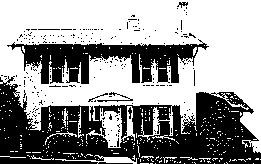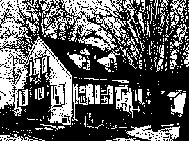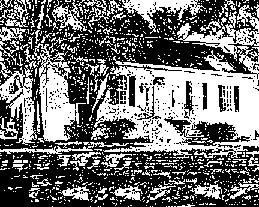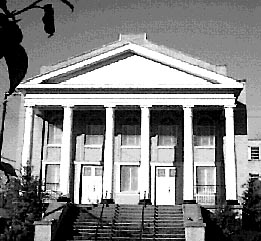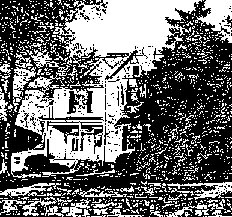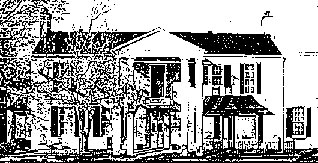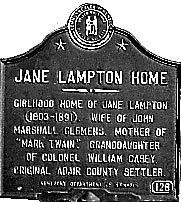| ||||||||||||
Dr. Ronald P. Rogers CHIROPRACTOR Support for your body's natural healing capabilities 270-384-5554 Click here for details 


Columbia Gas Dept. GAS LEAK or GAS SMELL Contact Numbers 24 hrs/ 365 days 270-384-2006 or 9-1-1 Call before you dig Visit ColumbiaMagazine's Directory of Churches Addresses, times, phone numbers and more for churches in Adair County Find Great Stuff in ColumbiaMagazine's Classified Ads Antiques, Help Wanted, Autos, Real Estate, Legal Notices, More... 

|
Walking Tour Of Columbia: Part III This article first appeared in issue 13, and was written by Vonnie Kolbenschlag. Continue to High Street and turn right toward Greensburg Street. 17. *1812 Columbia Academy The large white brick house on the left is built around what was once the first school building in Columbia. Town citizens built the academy from public subscription of $175, donated materials, labor worth $461, and a grant from the Kentucky Legislature for "institutions of learning." William Caldwell donated the land for a school with the stipulation that if part of the lot were ever used as a grave yard, it would return to him or his heirs. The building was 20 X 30 feet, two stories tall, and had 10 windows. There were two fireplaces on the first floor, one at either end, and three on the second floor. Sam B. Robertson, a Presbyterian minister, was the head master until he moved in 1825. Another minister, Daniel Page, continued. The girls were taught in the Field House. In 1836 the academy had 122 pupils. This has been a residence since the 1850's, at which time it was sold to a town merchant, W. H. Walker, who built the brick house beside it for his daughter. Both homes have been greatly remodeled. By 1854 the M & F School opened. Presbyterians were the main push behind these early schools. Perhaps William Casey, a Presbyterian, set a good early example. He hired a school teacher for the children living in his fort. He called for ministers to preach and teach. Columbia's elementary school is aptly named Colonel William Casey. Walk toward Greensburg Street. 18. *1941 * 108 High Street - This home was designed by Rachel Judd, an architect who lived in Columbia. This was not a usual profession for women in 1941. The builder was Demaree Richards, father of Jody Richards, Speaker of The Kentucky House of Representatives. The original owners still live here - she a retired school teacher and he a retired pharmacist and author who wrote an autobiography, Beyond the Brier Domain. His great, great grandparents were two of the earliest settlers in Adair County. 19. *1817 Nathan Gaither House National Register On the left corner is the 1 1/2 story house built by Dr. Nathan and Martha Morrison Gaither. One of his patients was anemic Peggy Casey (Mark Twain's maternal grandmother). Gaither treated anemia with iron filings in water for the patient to drink. While in medical school he volunteered himself in the testing of Jenner's smallpox vaccine. He was a surgeon in the War of 1812. He served in the state legislature and as a member of the Constitutional Convention of 1850. He was twice a member of the U.S. Congress. Dr. Gaither lost this home through security debts. The stone wall around the house is probably as old as the house. Martha Gaither's parents, the Morrisons, were great grandparents of Henry Watterson, noted editor of the Louisville Courier-Journal. The Morrison home once stood across Greensburg Street from the Gaithers. A first cousin of Nathan Gaither lived in Elizabethtown. His house is also on the National Register. Other doctors have lived in this house in the past. Notice the small building next to the house - once a doctor's office. The Appalachian Research and Defense Fund owns the "Gaither" house now. 20 *1901 J.B. Barbee House Opposite Gaither's house is the house where J.B. Barbee, the last operator of the Columbia-Campbellsville Stage Line once lived. The house has 42 windows, eight of which are mullioned cathedral stained glass. This house was the first in town to have concrete sidewalks. In 1886 a public poll queried, " Some think there should be a stage line between Columbia and Campbellsville. How do you feel? Stage coaches made two round trips to Campbellsville a day (except Sundays) from 1893 - 1912 to make train connections. Adair County never had a railroad. From the stables on High Street, horses and stage would turn onto Greensburg Street, load or unload in front of the hotel (present Courthouse Annex site) and proceed to Campbellsville pulled by four to six horses that were changed at Green River where "Buck" Barbee had a barn and extra horses. When the bridge burned, passengers were ferried across. A coach carried six or seven passengers and mail. Heavy trunks were loaded on top. Drivers had no protection from the weather. Cost was $1.50, or if a preacher, $1.00. Coaches cost about $2,000. Passengers once demanded a good stage be burned because a man with smallpox had ridden in it. The last commercial stage coach used in Kentucky, one that made the Columbia-Campbellsville run, is now the centerpiece of the Wells Fargo Bank and Museum in Los Angeles. Turn right onto Greensburg Street and walk toward the Square. 21. *1857 Across Greensburg Street is Stotts Phelps McQueary Funeral Home in a building that originally was Columbia's third jail. A jail was the first building - 1803-on the Square. The second - 1817 - and third jails - 1857 -were on this lot. The third (1857) jail was renovated in 1922 into a funeral home, which has been restored, expanded, and refurbished over the years. The fourth jail was built next to the funeral home. It was used until the fifth and present regional jail was built in 1985. 22. *1929 Columbia Baptist Church is the fourth Baptist Church on the same site. The wing in back was completed in 1958. Dan and Mary Trabue were part of the earliest congregation organized in 1827, but these Baptists met in the Courthouse until funds were available to buy a lot and build. The first Columbia Baptist Church, a one room frame building, was built in 1844. It was replaced in 1878. In 1915 a new brick church was built. In 1928 that church burned, and the present one was built. In 1839 The Columbia Temperance Society was organized by the Baptist Church. Columbia was the first town in Kentucky to prohibit the sale of intoxicants. An exception was made for tavern keepers, but before they could sell, a license was required from the town trustees. The granting of the license was discretionary with them. The temperance sentiment prevailed, but it was not until 1874 that Kentucky had local option elections to determine the sale of alcoholic beverages. In 1814 Benjamin and Peggy Lampton (Mark Twain's grandparents) and their two daughters lived in a house on the lot next to where the Baptist Church now stands. Local clay bricks used by Lampton to build their small house were not rosy red such as he remembered in Virginia. To remedy that, he painted the bricks, but his color turned out pink. People called it the "Pink Cottage." Peggy died in 1817. Their daughters, Jane (Mark Twain's mother) and Patsy went to live with relatives. In a few years Benjamin married Polly Hays. The girls were instructed to call their stepmother "Aunt Polly." In 1900 the Pink Cottage was torn down and the bricks recycled to build the present brick house. Mark Twain "recycled" his mom's stories of Aunt Polly. Notice the marker located next to the flower bed in front of the video store. This story was posted on 1997-05-05 12:01:01
Printable: this page is now automatically formatted for printing.
Have comments or corrections for this story? Use our contact form and let us know.
More articles from topic Articles from the Print Edition:
Want To Help Solve The Columbia Bagel And Bread Crisis? My Favorite Word: W'sat? Columbia Now Has Creative Banner Maker Letter To The Editor Letter To The Editor Letter To The Editor Leon's Opens In Columbia Walking Tour Of Columbia: Part I Sulphur Well Had Its Own Version Of Thoreau Old Sulphur Well Kentucky View even more articles in topic Articles from the Print Edition |


|
||||||||||
|
| ||||||||||||
|
Quick Links to Popular Features
Looking for a story or picture? Try our Photo Archive or our Stories Archive for all the information that's appeared on ColumbiaMagazine.com. | ||||||||||||
|
Contact us: Columbia Magazine and columbiamagazine.com are published by Linda Waggener and Pen Waggener, PO Box 906, Columbia, KY 42728. Please use our contact page, or send questions about technical issues with this site to webmaster@columbiamagazine.com. All logos and trademarks used on this site are property of their respective owners. All comments remain the property and responsibility of their posters, all articles and photos remain the property of their creators, and all the rest is copyright 1995-Present by Columbia Magazine. Privacy policy: use of this site requires no sharing of information. Voluntarily shared information may be published and made available to the public on this site and/or stored electronically. Anonymous submissions will be subject to additional verification. Cookies are not required to use our site. However, if you have cookies enabled in your web browser, some of our advertisers may use cookies for interest-based advertising across multiple domains. For more information about third-party advertising, visit the NAI web privacy site.
| ||||||||||||
























